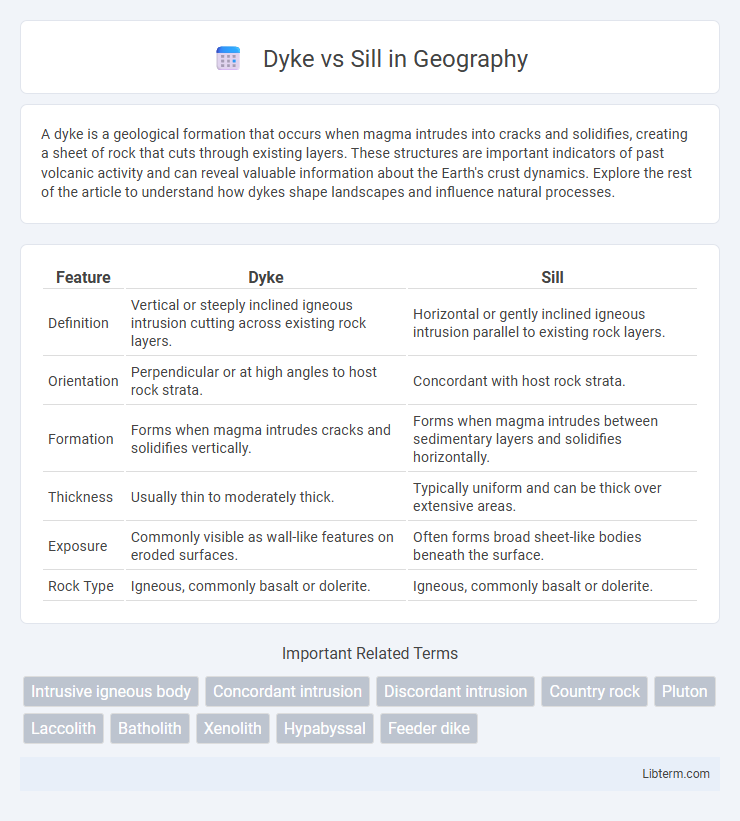A dyke is a geological formation that occurs when magma intrudes into cracks and solidifies, creating a sheet of rock that cuts through existing layers. These structures are important indicators of past volcanic activity and can reveal valuable information about the Earth's crust dynamics. Explore the rest of the article to understand how dykes shape landscapes and influence natural processes.
Table of Comparison
| Feature | Dyke | Sill |
|---|---|---|
| Definition | Vertical or steeply inclined igneous intrusion cutting across existing rock layers. | Horizontal or gently inclined igneous intrusion parallel to existing rock layers. |
| Orientation | Perpendicular or at high angles to host rock strata. | Concordant with host rock strata. |
| Formation | Forms when magma intrudes cracks and solidifies vertically. | Forms when magma intrudes between sedimentary layers and solidifies horizontally. |
| Thickness | Usually thin to moderately thick. | Typically uniform and can be thick over extensive areas. |
| Exposure | Commonly visible as wall-like features on eroded surfaces. | Often forms broad sheet-like bodies beneath the surface. |
| Rock Type | Igneous, commonly basalt or dolerite. | Igneous, commonly basalt or dolerite. |
Introduction to Dykes and Sills
Dykes and sills are types of igneous intrusions formed when magma intrudes into pre-existing rock layers and solidifies. Dykes cut across sedimentary layers vertically or steeply, creating discordant bodies, while sills intrude parallel to bedding planes, forming concordant sheets. Both structures provide valuable insights into the geological history and tectonic settings of an area.
Defining Dykes: Geological Characteristics
Dykes are vertical or steeply inclined sheets of igneous rock that cut through preexisting rock formations, formed when magma intrudes into fractures and solidifies. They are typically finer-grained than sills due to faster cooling, exhibit sharp contacts with surrounding rocks, and often display columnar jointing perpendicular to their surfaces. Dykes can vary in thickness from centimeters to meters and serve as key indicators of past tectonic stress orientations and magma movement within the Earth's crust.
Understanding Sills: Key Features
Sills are tabular igneous intrusions that form parallel to existing rock layers, often creating horizontal or gently inclined sheets within sedimentary strata. Unlike dikes, which cut across rock layers vertically or steeply, sills propagate along bedding planes, resulting in minimal disruption to the host rock's original layering. Key features include their concordant orientation, intrusive nature, and potential to influence local thermal metamorphism and mineral deposition.
Formation Processes of Dykes
Dykes form when magma intrudes into pre-existing rock fractures, cutting across existing layers as it solidifies, often creating vertical or steeply inclined sheets. This intrusion occurs due to tectonic stresses that generate cracks, allowing molten rock to rise and fill these openings rapidly, resulting in fine-grained or porphyritic textures depending on cooling rates. Unlike sills, which form parallel to rock strata, dykes represent discordant features that provide critical insights into the direction and dynamics of ancient magmatic intrusions.
Formation Mechanisms of Sills
Sills form through the intrusion of magma between parallel layers of pre-existing rock, exploiting zones of weakness and bedding planes where horizontal stress is minimal. The magma solidifies while maintaining concordance with the surrounding strata, creating tabular, sheet-like bodies that contrast with the vertical or steeply inclined orientation typical of dikes. This process involves the injection of magma at relatively shallow depths, resulting in intrusive bodies that can influence local stratigraphy and metamorphism.
Key Differences Between Dykes and Sills
Dykes are vertical or steeply inclined tabular igneous intrusions that cut across existing rock layers, while sills are horizontal or gently inclined intrusions that parallel the bedding planes. Dykes typically form when magma forces its way through fractures, creating wall-like structures, whereas sills intrude between sedimentary layers, causing uplift without breaking across strata. The contrasting orientations and modes of emplacement distinguish dykes as cross-cutting features and sills as concordant intrusions aligned with pre-existing rock formations.
Petrology and Mineral Composition
Dykes and sills are igneous intrusions with distinct orientations but differ in petrology primarily due to cooling rates and mineral crystallization environments. Dykes, cutting across pre-existing rock layers, often exhibit finer-grained textures with minerals such as plagioclase, pyroxene, and olivine, indicative of rapid cooling and shallow emplacement. Sills, parallel to bedding planes, typically show coarser-grained textures with well-developed feldspar and biotite crystals, reflecting slower cooling and more extensive mineral growth in a stable thermal environment.
Importance in Geological Mapping
Dykes and sills are crucial in geological mapping because they provide important information about the intrusion of magma and the stress regime in the Earth's crust. Dykes cut across pre-existing rock layers vertically or steeply, indicating pathways of magma movement, while sills intrude parallel to bedding planes, revealing magma emplacement horizontally. Mapping these features helps geologists reconstruct tectonic settings, understand crustal deformation, and assess mineralization zones.
Economic Significance of Dykes and Sills
Dykes and sills, as intrusive igneous formations, play a crucial role in mineral exploration and mining because they often host economically valuable minerals like gold, copper, and nickel. Their formation pathways can influence the localization of ore deposits, making them important targets for geological surveys and resource extraction. Understanding the distribution of dykes and sills helps geologists assess the economic potential of mining regions and develop more efficient extraction strategies.
Notable Examples Around the World
Notable examples of dykes include the Palisades Sill along the Hudson River in the United States, characterized by its steep cliffs formed from solidified magma injected into vertical fractures. Sills are prominently exemplified by the Great Whin Sill in Northern England, where horizontal magma intrusions created extensive, layered rock formations. The Columbia River Basalt Group in the Pacific Northwest showcases both dykes and sills, illustrating diverse intrusive processes and their influence on regional geology.
Dyke Infographic

 libterm.com
libterm.com